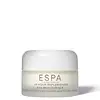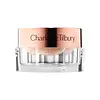What's inside
What's inside
 Key Ingredients
Key Ingredients

 Benefits
Benefits

 Concerns
Concerns

 Ingredients Side-by-side
Ingredients Side-by-side

Water
Skin ConditioningGlycerin
HumectantCaprylic/Capric Triglyceride
MaskingIsopropyl Palmitate
EmollientCetearyl Alcohol
EmollientGlyceryl Stearate
EmollientPolysorbate 60
EmulsifyingSorbitol
HumectantPrunus Amygdalus Dulcis Oil
Skin ConditioningSodium PCA
HumectantPhenoxyethanol
PreservativeBorago Officinalis Seed Oil
EmollientGlycine Soja Oil
EmollientSimmondsia Chinensis Seed Oil
EmollientXanthan Gum
EmulsifyingOlea Europaea Fruit Oil
MaskingCentaurea Cyanus Flower Extract
AstringentTocopherol
AntioxidantHydrogenated Vegetable Oil
EmollientOenothera Biennis Oil
EmollientCentella Asiatica Leaf Extract
Skin ConditioningMacadamia Ternifolia Seed Oil
EmollientPrunus Persica Kernel Oil
EmollientBenzoic Acid
MaskingGlyceryl Polyacrylate
Helianthus Annuus Seed Oil
EmollientSodium Lactate
BufferingDehydroacetic Acid
PreservativeAniba Rosaeodora Wood Oil
AstringentPelargonium Graveolens Oil
MaskingLinalool
PerfumingCaprylyl Glycol
EmollientSorbitan Stearate
EmulsifyingEthylhexylglycerin
Skin ConditioningGinkgo Biloba Leaf Extract
Skin ConditioningParfum
MaskingSodium Hydroxide
BufferingBoswellia Carterii Gum Oil
PerfumingCitrus Aurantium Amara Flower Oil
MaskingSalvia Sclarea Oil
MaskingSantalum Album Oil
MaskingBenzyl Alcohol
PerfumingGeraniol
PerfumingAnthemis Nobilis Flower Oil
MaskingPotassium Sorbate
PreservativeLimonene
PerfumingStyrax Tonkinensis Resin Extract
PerfumingMaltodextrin
AbsorbentChlorophyllin-Copper Complex
AntioxidantWater, Glycerin, Caprylic/Capric Triglyceride, Isopropyl Palmitate, Cetearyl Alcohol, Glyceryl Stearate, Polysorbate 60, Sorbitol, Prunus Amygdalus Dulcis Oil, Sodium PCA, Phenoxyethanol, Borago Officinalis Seed Oil, Glycine Soja Oil, Simmondsia Chinensis Seed Oil, Xanthan Gum, Olea Europaea Fruit Oil, Centaurea Cyanus Flower Extract, Tocopherol, Hydrogenated Vegetable Oil, Oenothera Biennis Oil, Centella Asiatica Leaf Extract, Macadamia Ternifolia Seed Oil, Prunus Persica Kernel Oil, Benzoic Acid, Glyceryl Polyacrylate, Helianthus Annuus Seed Oil, Sodium Lactate, Dehydroacetic Acid, Aniba Rosaeodora Wood Oil, Pelargonium Graveolens Oil, Linalool, Caprylyl Glycol, Sorbitan Stearate, Ethylhexylglycerin, Ginkgo Biloba Leaf Extract, Parfum, Sodium Hydroxide, Boswellia Carterii Gum Oil, Citrus Aurantium Amara Flower Oil, Salvia Sclarea Oil, Santalum Album Oil, Benzyl Alcohol, Geraniol, Anthemis Nobilis Flower Oil, Potassium Sorbate, Limonene, Styrax Tonkinensis Resin Extract, Maltodextrin, Chlorophyllin-Copper Complex
Water
Skin ConditioningCaprylic/Capric Triglyceride
MaskingButylene Glycol
HumectantPolysorbate 60
EmulsifyingOlus Oil
EmollientPEG-7 Glyceryl Cocoate
EmulsifyingGlycerin
HumectantButyrospermum Parkii Butter
Skin ConditioningPEG-8
HumectantEthylhexyl Stearate
EmollientDicaprylyl Ether
EmollientSorbitan Stearate
EmulsifyingHydroxyethyl Acrylate/Sodium Acryloyldimethyl Taurate Copolymer
Emulsion StabilisingOlive Oil PEG-7 Esters
EmollientPhenoxyethanol
PreservativeSaccharide Isomerate
HumectantC12-16 Alcohols
EmollientCera Alba
EmollientGlyceryl Stearate
EmollientHydrogenated Castor Oil
EmollientSqualane
EmollientEthylhexylglycerin
Skin ConditioningChlorphenesin
AntimicrobialHydrogenated Lecithin
EmulsifyingHydrolyzed Rice Protein
Skin ConditioningPalmitic Acid
EmollientXanthan Gum
EmulsifyingChondrus Crispus Extract
Skin ConditioningDisodium EDTA
Helianthus Annuus Seed Oil
EmollientPolysorbate 20
EmulsifyingSorbitan Isostearate
EmulsifyingSodium Hydroxide
BufferingGlycine Soja Protein
EmulsifyingSuperoxide Dismutase
AntioxidantCitric Acid
BufferingHydroxypropyl Cyclodextrin
MaskingTocopherol
AntioxidantSodium Citrate
BufferingSodium Benzoate
MaskingSodium PCA
HumectantAscorbyl Palmitate
AntioxidantDaphne Odora Callus Extract
Skin ProtectingSodium Dextran Sulfate
Gel FormingNicotiana Sylvestris Leaf Cell Culture
Skin ConditioningAluminum Hydroxide
EmollientRetinol
Skin ConditioningPlumeria Rubra Flower Extract
Skin ConditioningBorago Officinalis Seed Oil
EmollientTocopheryl Acetate
AntioxidantAscorbic Acid
AntioxidantLecithin
EmollientPotassium Sorbate
PreservativeRetinyl Palmitate
Skin ConditioningAscorbyl Tetraisopalmitate
AntioxidantCI 77891
Cosmetic ColorantIron Oxides
Water, Caprylic/Capric Triglyceride, Butylene Glycol, Polysorbate 60, Olus Oil, PEG-7 Glyceryl Cocoate, Glycerin, Butyrospermum Parkii Butter, PEG-8, Ethylhexyl Stearate, Dicaprylyl Ether, Sorbitan Stearate, Hydroxyethyl Acrylate/Sodium Acryloyldimethyl Taurate Copolymer, Olive Oil PEG-7 Esters, Phenoxyethanol, Saccharide Isomerate, C12-16 Alcohols, Cera Alba, Glyceryl Stearate, Hydrogenated Castor Oil, Squalane, Ethylhexylglycerin, Chlorphenesin, Hydrogenated Lecithin, Hydrolyzed Rice Protein, Palmitic Acid, Xanthan Gum, Chondrus Crispus Extract, Disodium EDTA, Helianthus Annuus Seed Oil, Polysorbate 20, Sorbitan Isostearate, Sodium Hydroxide, Glycine Soja Protein, Superoxide Dismutase, Citric Acid, Hydroxypropyl Cyclodextrin, Tocopherol, Sodium Citrate, Sodium Benzoate, Sodium PCA, Ascorbyl Palmitate, Daphne Odora Callus Extract, Sodium Dextran Sulfate, Nicotiana Sylvestris Leaf Cell Culture, Aluminum Hydroxide, Retinol, Plumeria Rubra Flower Extract, Borago Officinalis Seed Oil, Tocopheryl Acetate, Ascorbic Acid, Lecithin, Potassium Sorbate, Retinyl Palmitate, Ascorbyl Tetraisopalmitate, CI 77891, Iron Oxides
Ingredients Explained
These ingredients are found in both products.
Ingredients higher up in an ingredient list are typically present in a larger amount.
Borago Officinalis Seed Oil is from the seeds of the starflower plant. This plant grows primarily in Europe.
This oil does not have a scent. It contains fatty acids such as linolenic acid. These fatty acids help keep skin hydrated.
Borago Officinalis Seed Oil is an antioxidant. Antioxidants help fight free-radicals. Free-radicals are molecules that may damage your skin cells.
Learn more about Borago Officinalis Seed OilThis ingredient is an emollient, solvent, and texture enhancer. It is considered a skin-softener by helping the skin prevent moisture loss.
It helps thicken a product's formula and makes it easier to spread by dissolving clumping compounds.
Caprylic Triglyceride is made by combining glycerin with coconut oil, forming a clear liquid.
While there is an assumption Caprylic Triglyceride can clog pores due to it being derived from coconut oil, there is no research supporting this.
Learn more about Caprylic/Capric TriglycerideEthylhexylglycerin (we can't pronounce this either) is commonly used as a preservative and skin softener. It is derived from glyceryl.
You might see Ethylhexylglycerin often paired with other preservatives such as phenoxyethanol. Ethylhexylglycerin has been found to increase the effectiveness of these other preservatives.
Glycerin is already naturally found in your skin. It helps moisturize and protect your skin.
A study from 2016 found glycerin to be more effective as a humectant than AHAs and hyaluronic acid.
As a humectant, it helps the skin stay hydrated by pulling moisture to your skin. The low molecular weight of glycerin allows it to pull moisture into the deeper layers of your skin.
Hydrated skin improves your skin barrier; Your skin barrier helps protect against irritants and bacteria.
Glycerin has also been found to have antimicrobial and antiviral properties. Due to these properties, glycerin is often used in wound and burn treatments.
In cosmetics, glycerin is usually derived from plants such as soybean or palm. However, it can also be sourced from animals, such as tallow or animal fat.
This ingredient is organic, colorless, odorless, and non-toxic.
Glycerin is the name for this ingredient in American English. British English uses Glycerol/Glycerine.
Learn more about GlycerinGlyceryl Stearate is a mix of glycerin and stearic acid.
It is used to stabilize the mixing of water and oil ingredients. By preventing these ingredients from separating, it can help elongate shelf life. It can also help thicken the product's texture.
As an emollient, it helps soften skin and supports barrier-replenishing ingredients.
In cosmetics, Glyceryl Stearate is often made from vegetable oils or synthetically produced.
This ingredient may not be fungal-acne safe
Fun fact: The human body also creates Glyceryl Stearate naturally.
Learn more about Glyceryl StearateHelianthus Annuus Seed Oil is the oil derived from the seeds of a Sunflower. Sunflower seed oil is non-fragrant. It is an emollient, meaning it helps to soften the skin.
Sunflower seed oil contains many fatty acids. The fatty acids found in sunflower seeds include (from highest amount to least): linoleic acid, myristic acid, palmitic acid, stearic acid, arachidic acid, oleic acid, and linolenic acid.
These fatty acids help the skin create ceramides. Ceramides play a role in repairing the skin barrier.
Helianthus Annuus Seed Oil helps moisturize the skin. This in turn helps the skin look more rejuvenated and smoother.
Sunflowers are rich in vitamin E.
Historians believe Indigenous cultures of North America domesticated sunflowers before corn. Thus they relied on sunflower oil for a variety of uses. One such use is moisturizing skin and hair.
Sunflower seed oil may not be fungal acne safe. We recommend speaking with a professional if you have any concerns.
Learn more about Helianthus Annuus Seed OilPhenoxyethanol is a preservative that has germicide, antimicrobial, and aromatic properties. Studies show that phenoxyethanol can prevent microbial growth. By itself, it has a scent that is similar to that of a rose.
It's often used in formulations along with Caprylyl Glycol to preserve the shelf life of products.
Polysorbate 60 is used to help stabilize products. It is a surfactant and emulsifier. These properties help keep ingredients together in a product. Surfactants help reduce surface tension between ingredients with different states, such as liquids and solids. Emulsifiers help prevent oils and waters from separating.
Polysorbate 60 is sorbitol-based and created from the ethoxylation of sorbitan. Ethoxylation is a chemical reaction used to add ethylene oxide. Sorbitan is a the dehydrated version of sorbitol, a sugar found in fruits.
In this case, the 60 comes from reacting 60 units of ethylene oxide with sorbitan.
Polysorbates are commonly used in medicine and foods.
Learn more about Polysorbate 60Potassium Sorbate is a preservative used to prevent yeast and mold in products. It is commonly found in both cosmetic and food products.
This ingredient comes from potassium salt derived from sorbic acid. Sorbic acid is a natural antibiotic and effective against fungus.
Both potassium sorbate and sorbic acid can be found in baked goods, cheeses, dried meats, dried fruit, ice cream, pickles, wine, yogurt, and more.
You'll often find this ingredient used with other preservatives.
Learn more about Potassium SorbateSodium Hydroxide is also known as lye or caustic soda. It is used to adjust the pH of products; many ingredients require a specific pH to be effective.
In small amounts, sodium hydroxide is considered safe to use. However, large amounts may cause chemical burns due to its high alkaline.
Your skin has a natural pH and acid mantle. This acid mantle helps prevent harmful bacteria from breaking through. The acid mantle also helps keep your skin hydrated.
"Alkaline" refers to a high pH level. A low pH level would be considered acidic.
Learn more about Sodium HydroxideSodium PCA is the sodium salt of pyroglutamic acid. It is naturally occurring in our skin's natural moisturizing factors where it works to maintain hydration.
The PCA stands for pyrrolidone carboxylic acid, a natural amino acid derivative.
This ingredient has skin conditioning, anti-inflammatory, and humectant properties. Humectants help hydrate your skin by drawing moisture from the air. This helps keep your skin moisturized.
Learn more about Sodium PCASorbitan Stearate comes from sorbitol and stearic acid. Sorbitol is a type of sugar and stearic acid is a fatty acid.
It is used as an emulsifier and helps ingredients stay together by creating water-in-oil emulsions.
This ingredient may not be Malassezia folliculitis, or fungal-acne safe.
Tocopherol (also known as Vitamin E) is a common antioxidant used to help protect the skin from free-radicals and strengthen the skin barrier. It's also fat soluble - this means our skin is great at absorbing it.
Vitamin E also helps keep your natural skin lipids healthy. Your lipid skin barrier naturally consists of lipids, ceramides, and fatty acids. Vitamin E offers extra protection for your skin’s lipid barrier, keeping your skin healthy and nourished.
Another benefit is a bit of UV protection. Vitamin E helps reduce the damage caused by UVB rays. (It should not replace your sunscreen). Combining it with Vitamin C can decrease sunburned cells and hyperpigmentation after UV exposure.
You might have noticed Vitamin E + C often paired together. This is because it is great at stabilizing Vitamin C. Using the two together helps increase the effectiveness of both ingredients.
There are often claims that Vitamin E can reduce/prevent scarring, but these claims haven't been confirmed by scientific research.
Learn more about TocopherolWater. It's the most common cosmetic ingredient of all. You'll usually see it at the top of ingredient lists, meaning that it makes up the largest part of the product.
So why is it so popular? Water most often acts as a solvent - this means that it helps dissolve other ingredients into the formulation.
You'll also recognize water as that liquid we all need to stay alive. If you see this, drink a glass of water. Stay hydrated!
Learn more about WaterXanthan gum is used as a stabilizer and thickener within cosmetic products. It helps give products a sticky, thick feeling - preventing them from being too runny.
On the technical side of things, xanthan gum is a polysaccharide - a combination consisting of multiple sugar molecules bonded together.
Xanthan gum is a pretty common and great ingredient. It is a natural, non-toxic, non-irritating ingredient that is also commonly used in food products.
Learn more about Xanthan Gum